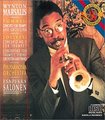| All Artists: Ludwig van Beethoven, Herbert von Karajan, Berlin Philharmonic Orchestra Title: Beethoven: Symphonies Nos. 1 & 2 Members Wishing: 0 Total Copies: 0 Label: Deutsche Grammophon Release Date: 11/9/1993 Genre: Classical Styles: Historical Periods, Classical (c.1770-1830), Modern, 20th, & 21st Century, Symphonies Number of Discs: 1 SwapaCD Credits: 1 UPC: 028943900126 |
Search - Ludwig van Beethoven, Herbert von Karajan, Berlin Philharmonic Orchestra :: Beethoven: Symphonies Nos. 1 & 2
 | Ludwig van Beethoven, Herbert von Karajan, Berlin Philharmonic Orchestra Beethoven: Symphonies Nos. 1 & 2 Genre: Classical
|
Larger Image |
CD DetailsSimilarly Requested CDs |
CD ReviewsKarajan's final Beethoven Symphony recordings were among my Alan Majeska | Bad Axe, MI, USA | 10/08/2005 (3 out of 5 stars) "This disc has nostalgia value, as it was one of the first CDs I owned in 1986, the beginning of my CD experience. I expected much of Karajan's final Beethoven recordings but was disappointed. The sound is not as natural and there is not enough treble in the highest registers as the earlier DG Beethoven Symphony recordings made in 1961-2 and 1975-77, but what concerns me most are the tempos. Some of the Allegro movements are too slow: sluggish, and in the words of one critic around the time this was released,"like Klemperer on a bad day." Apt, I'm afraid. I don't mean to be too hard on Karajan (1908-1989) who was without a doubt one of the great conductors of the 20th century, and made a huge number of recordings from 1947 until his death in 1989, mostly for DG, Decca, and EMI. But these recordings are disappointing, and there are so many to choose from for these works. Still, if you are a Karajan fan, go for them. I found Symphony 2 to be better played here than Symphony 1, but that may be only my perception. For both Symphonies, I like recordings by Bruno Walter (Sony), Karl Bohm (DG), or Karajan's earlier Berlin recordings (1961, 1975 - both DG, but analog sound) better than these." It all begins here, you know... ewomack | MN USA | 03/30/2004 (5 out of 5 stars) "Beethoven's symphonies are beyond doubt some of the greatest works of music produced by the western world. Their popularity has not waned since the time of their composition, and there doesn't seem to be an end to their appeal.The first and second symphonies (along with the 8th) are probably the least well-known and popular amongst those Beethoven composed. Nonetheless, they're great in their own right. It's almost unfair to compare anything to Beethoven's 5th, 6th or 9th symphonies, and that goes for the 1st and the 2nd symphonies as well. Sure, there are no immediately recognizable tunes here for the neophyte listener, such as in the 5th sympony which is immediately recognizable to people of almost any age. There may also be no standout melodies that stick in the mind indelibly when the music stops. Still, the first symphony is quite an acheivement despite its lower status amongst the nine.In reading about the 1st symphony, one finds that it is considered to be in the more classic style akin to Hadyn or Mozart - two symphonic forms that were at first thought to be unsurpassable. Due to this, Beethoven had some work to do before scribbling up his 1st symphony. There were big shoes to fill in the symphonic tradition (much the same problem that Beethoven's "successor" Brahms had when contemplating his own first symphony). In almost complete defiance of the intimidating tradition that lay before Beethoven, he managed to compose an excellent classic symphony as well as expand on that very same form. Critics at the time (around 1800) were astounded, and hailed the end of the classical period. The praise was well founded, the symphony is a strong one. The first movement contains powerful creshendoes that culminate in a good Beethoven pounding. The piece is filled with provocative and interesting phrases throughout (including the Don Giovanni-esque opening to the 4th movement). Anyone would want their first symphony to be this good.The second symphony is intriguing not only because the music is spectacular, but because it was written in 1801-1802 when Beethoven's deafness began to - probably horrifyingly - set in. There is no sign of this in the piece itself which has the same umph felt and heard in the first symphony. It is probably fair to say that Beethoven developed a little more past the classic tradition in this work, but cautiously. The first movement has many soon to be familiar Beethoven stylings. The second movement is more methodical and mellow than anything in the first symphony; it begins with thick juicy strings, and remains mostly contemplative throughout until the strings burst forth suddenly, then just as suddenly dip back to a meditative state. The fourth movement begins with roller coaster strings, and remains mostly uptempo and powerful throughout.The recordings are wonderful; Karajan has a way with Beethoven, and symphonic recordings in general. This one is no exception. The CD is only a little over an hour, but it makes for a very full one. For Beethoven, it only gets better and better from here (which is almost unimaginable - the 3rd symphony somehow expanded on his first two and is now one of Beethoven's most famous works, and all of this with impending deafness!). Beethoven changed the symphony forever, and this CD contains the seminal pieces for that innovation." An outstanding Second Sym. from Karajan's last cycle Santa Fe Listener | Santa Fe, NM USA | 07/14/2006 (4 out of 5 stars) "Karajan was old-fashioned enough to see little difference between early and late Beethoven style. He wasn't inlined to treat Sym. #1 and 2 as holdovers from the age of Haydn; they speak in Beethoven's mature voice. To some extent this approach is dated. The First in particular seems a bit lumbering under Karajan, and the Berlin Phil. feel constrained, holding back their power while still remaining at full force. (Abbado would drastically scale back the number of musicians in his cycle from Berlin.) The result is a proficient but rather joyless reading.
The Second is another story. There's enough real Beethoven here for Karajan to allow his musicians to expand. This Second is large-scale and often muscular, even in the soft-hearted Larghetto. Again, not the true historical story but true to German tradition. In other symphonies Karajan modernizes tradition by being faster and leaner; here he doesn't. Thanks to Karajan's talents, his traditional reading is convincingly alive. In fact, unless you demand period style, this is one of the best Seconds to be had, and the improved sonics of the Karajan Gold edition surpass the sound DG produed for Karajan's two ealier versions form the Sixties and Seventies." |

 Track Listings (8) - Disc #1
Track Listings (8) - Disc #1




